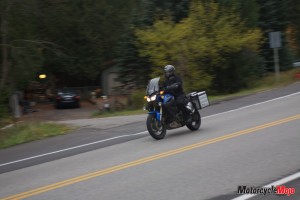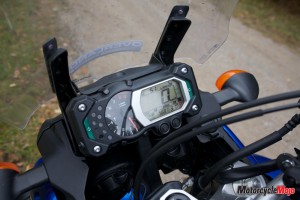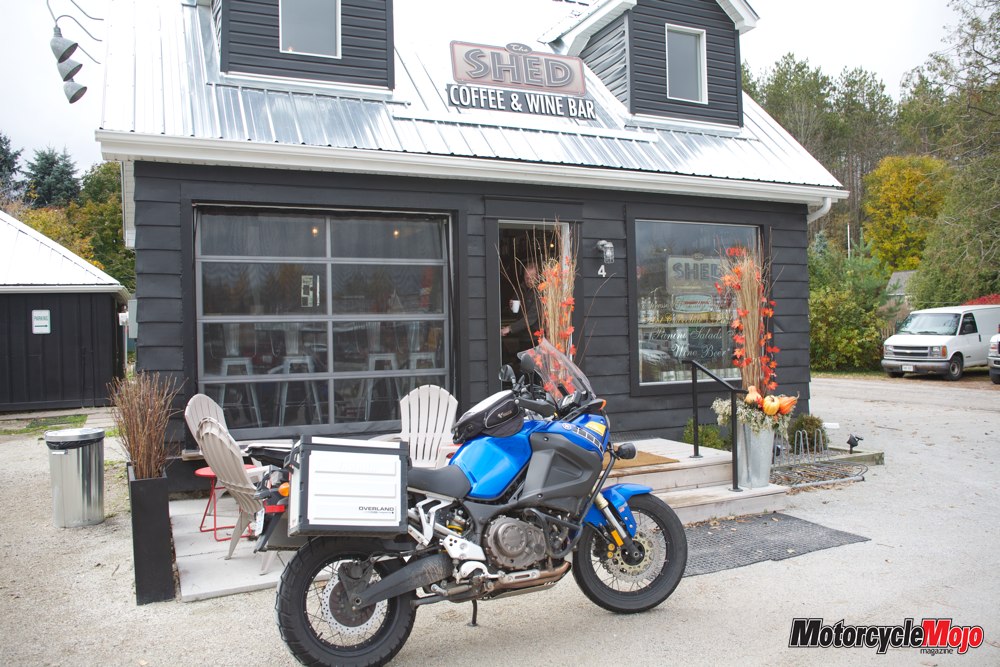I collected a 2012 model XTZ 1200 Super Ténéré from Yamaha HQ in Toronto. A press bike, it already had 8000 km on the odometer, and there’s nothing like a bike that’s been abused by heavy-handed journalists to give an idea of how it withstands abuse in the long run.
As a first long day, I rode 700 km to Sault Ste. Marie. I have to say the stock seat must be one of the best on the market, and the ergonomics are simply perfect. No part of me ached, even mildly, as I got used to the seating position, and the rubber foot-peg inserts provide excellent isolation from any vibration. The look of a machine is certainly important, but instant and enduring comfort always scores points with me, so the Super Ten and I appeared to be at the start of a beautiful relationship. Then I investigated the sandy logging tracks of northern Michigan and was reminded of two things: the bike’s incredible weight and my lack of off-road skill.
Yamaha reintroduced the Super Ténéré name with this model in 2010. It’s one they used throughout the 1990s on their 750 “adventure” model, which unfortunately was never available in North America. It is certainly emotive nomenclature, but North Africa’s Ténéré desert is not somewhere I’d feel confident on this machine. Yamaha’s use of the Saharan name is certainly legit, as their machinery has its fair share of Dakar Rally wins, but I just couldn’t relax in the soft, rutted sand, and with the panniers loaded and tank-bag on, it was tough, slow work.
 As a machine to manhandle in a parking lot, I wished that it had been on a diet and wasn’t 261 kg wet (before luggage). Of course, like all motorcycles, it sheds most of that excessive weight almost as soon as it’s moving. The weight’s low for easy balance, but shoving it around manually, you experience every kilogram.
As a machine to manhandle in a parking lot, I wished that it had been on a diet and wasn’t 261 kg wet (before luggage). Of course, like all motorcycles, it sheds most of that excessive weight almost as soon as it’s moving. The weight’s low for easy balance, but shoving it around manually, you experience every kilogram.
Out on the tarmac, it is stable and supremely comfortable. On the move, the Super Ten is a motorcycling Cadillac, simply wafting along as the 43 mm, upside-down front forks and rear monoshock suspension absorb undulations and irregularities with aplomb. I’m not one for obsessively fiddling with suspension settings, so I can tell you little about the minor differences that may be achieved. I found the factory settings plush enough for comfort and taut enough for undercarriage abuse on the twisties, like Highway 129 towards Chapleau, Ontario. If this is a machine you will use to commute to work or to enjoy on a weekend, then I’m sure all the adjustment possibilities could come into their own, but laden with luggage for a few months away, surely just winding up the preload to suit the size of your wardrobe would be ample?
Back in the comfortable, standard saddle (manually adjustable dual height of 845 or 870 mm (33.3 or 34.3 in.)), the dashboard layout offers an interesting mix of digital and analog. The tach needle sweeps conventionally, while the speed registers with huge, easy-to-read digital figures – and if the GPS is to be believed, it exaggerates by 9%. Beside the speedo is a vertical bar fuel gauge and clock, options for engine or atmospheric temperature, fuel efficiency (average and instant), two trip meters and mode settings for power and traction control.
 Most of the readout options are available through the use of two dash-mounted buttons, easily pressed with winter gloves, but for the life of me I couldn’t work out how to alter the severity of the traction control system, which told me it was on setting “one” the whole time. Yes, I know that I could have read the handbook, but I’m a man damn it, so if it isn’t obvious, it must mean it isn’t an intuitive system. Well, that, and the fact that I didn’t actually have a handbook to refer to.
Most of the readout options are available through the use of two dash-mounted buttons, easily pressed with winter gloves, but for the life of me I couldn’t work out how to alter the severity of the traction control system, which told me it was on setting “one” the whole time. Yes, I know that I could have read the handbook, but I’m a man damn it, so if it isn’t obvious, it must mean it isn’t an intuitive system. Well, that, and the fact that I didn’t actually have a handbook to refer to.
The engine management settings, displayed as S for sport and T for touring, are accessed from the right-hand switchgear and can be altered on the move. Touring provides a softer and supposedly more economical power delivery, but I preferred the livelier S setting, still averaging 5.26 L/100 km. Doing the math after one fill-up showed I’d averaged only 7.63 L/100 km, and given that I hadn’t been “playing” for more than 160 km of that, economy must have plummeted into KTM territory during my fun time on that tank.
I initially considered the overall economy was poor as I wondered what happened to the bars on the fuel gauge and the flashing lights began, until I realized it was because the seat was so comfortable and I’d been sitting down for so long, watching the world go by. It’s a 23-litre tank, so at the best economy I managed, that would be over 400 km to fumes. Remember, I had luggage on at all times, but I can’t actually tell you the greatest distance I achieved between fill-ups.
The trip counter counts as it ought to. At a certain point, though, linked to the flashing fuel light, it goes back to zero, accompanied by the letter F, and starts counting again. If I wasn’t watching exactly when it did change, I couldn’t then add the two numbers together to get my total range. It was one of the most infuriating things, and could only have come to light after some time with the bike. I should have used the main odometer and written down my mileage at each gas station visit to keep a running total. If the onboard computer functions were supposed to be capable of so much, why couldn’t the trip counter just count until I reset it? If I’d had the handbook, then maybe I could have changed this setting.
Luckily, the Ten comes with a main stand which is a doddle to use. This means more fuel can be squeezed in if you take the time to let the air come out past the safety system. This is designed to ensure you can’t use all 23 litres, leaving some room for expansion. Riding in almost freezing conditions most of the time, fuel expansion wasn’t my greatest worry. Making sure I got to the next hot cup of tea was!
The standard-equipment hand guards were a godsend, but the optional heated grips weren’t fitted. Instead, the options bin had been raided for the PIAA spotlights, mounted on the crash bars that I thankfully never used. The accessory lights were undoubtedly good, but so was the standard projector-beam twin headlight.
The screen was a much taller Yamaha option too, and even though it created buffeting and noise for my 5 foot 10 height, the extra cold it deflected off my chest was well worth it. Even the mildly flared tank shape and body panels meant that my knees were afforded some protection.
The mirrors, unsurprisingly, didn’t contribute to warmth, but were perfect for letting me see behind. No vibration, a good shape, and positioned so that I wasn’t just looking at my jacket.
I’m glad they were so well made, because the bike did sometimes emit quite harsh vibrations, especially under even the slightest throttle load. It was a little confusing, because otherwise everything was so smooth, but it felt like it was coming from the final drive, not the engine, and wasn’t absolutely consistent. This could have been specific to the bike I used, but otherwise the shaft system couldn’t be faulted. There was none of the twisting or shaft jacking that is sometimes common on shaft-driven bikes. Encased in a very smart, cast-alloy swinging arm, it drove just like a chain but without the mess and maintenance.
Aside from the occasional vibration under load, the grunt of the parallel-twin is beautiful to live with. There’s always power available, no matter what part of the rev range you are in, and at four grand in sixth (the top gear), the speedo is reading 125 km/h. Perfect for roll-on overtakes, or hours of laid-back cruising.
The 84 ft-lb of torque and 108 hp are produced from the over-square engine, which will easily rev if you want it to, and the Mikuni injection system is seamless at any point, working with the ECU to measure throttle openings 1000 times per second and alter fuel, air and spark delivery to suit. Even with all that electronic management, there is still a characteristic gruffness combined with a pleasing induction sound, which taps into the psychological, petrolhead X-factor that makes motorcycling so much fun.
The 6-speed gearbox is slick on upshifts if you want to enjoy those revs and emotive sound, but I found downshifts clunky, especially when stationary at an intersection.
The wheels, by comparison, are things of beauty; anodized black with external lips to hold the spokes. This allows spokes to be replaced with wheels mounted, and allows tubeless tires to be used. The 110/80-19 up front and 150/70-17 rear tire are Metzeler Tourance EXPs, and although grip on the road is great, they are not dirt tires. Apart from my lack of off-road skill, they really didn’t help even on gravel roads, never mind the sand and snow I encountered. With the traction control set on level 1, it was possible to simply crack open the throttle and hope that everything would be sorted out automatically, but going into bends the same way will end in tears. It’s all very technologically advanced, linked as it is to the ABS, but I can’t help wondering what the result would be of a damaged sensor miles from home.
The rear Metzeler was completely finished by 10,000 km, but the front was still going strong at 14,000 km when I gave the bike back. I must say that the wavy brake rotors are superb on tarmac, and the Metzelers really bite into the road, but having the rear pedal banging against the sole of my foot was annoying, as the rear ABS seemed to cut in very early.
Apart from the tire consumption, the only other problems I encountered were an intermittent taillight and a clutch cut-out switch that couldn’t decide whether to work or not. To start the engine, sometimes I had to ensure neutral was selected whether the clutch was pulled or not. The ignition barrel and luggage locks required two major doses of WD40 in the two weeks I had the Super Ten. The ignition barrel simply refused to relinquish the key without it.
The luggage was Yamaha’s own plastic boxes. Rather quaintly, they have a thin sheet of aluminum stuck on the outside, which does at least provide a nice background for “I’ve been there” stickers. The lids hinge on the narrow, front edge and the aperture is full size, but you’ll want inner bags for ease of use. The boxes are easy to physically remove from their mounts, but without a top handle, you need two hands to carry each box, and if they’re dirty, all that filth will be rubbed on your clothes. The portside box has a large internal cutaway to accommodate the large silencer, and this really compromises the available luggage space.
The finish on frame and engine was unblemished when I finally washed the motorcycle at Mojo HQ. The tank and fairing silhouette already gives the bike a big chest, and the crash bar and bash-plate options accentuate the Super Ten’s butch appearance . . . and I love the Yamaha “speed block” graphic, which harks back to the racing heritage of the 1970s and 80s.
The Super Ténéré had the all-important aesthetic appeal that attracted a final glance as I walked away, every time I parked it. The adventure sector seems populated by bikes where function is more important than form, but if you are spending seventeen grand, it doesn’t hurt to like the look of the thing every morning.
Weight aside, our relationship really blossomed during the time we shared, and have I mentioned that I love the seat? Yes, day in, day out, I could really live with a Ténéré.



























